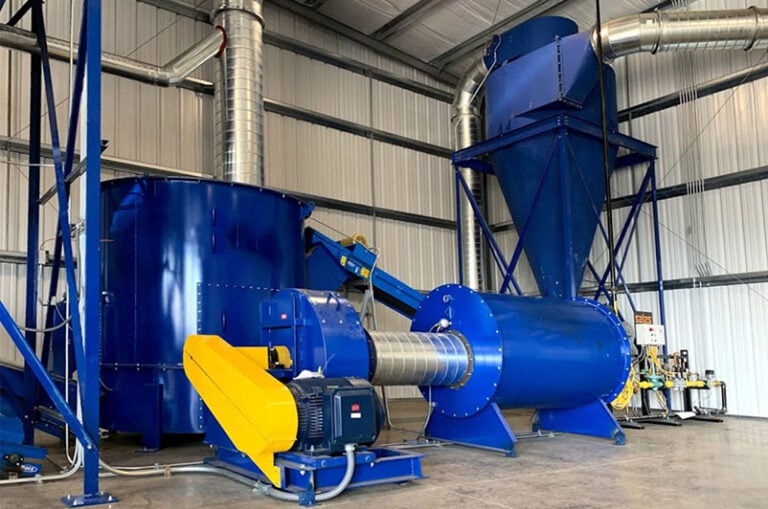Efficiently and effectively drying bulk solids is an essential aspect of modern industrial processing, no matter the industry. Among the various technologies available, fluid bed dryers have proven to be both diverse and reliable, as well as capable of processing a wide variety of materials.
The following provides a comprehensive introduction to these industrial drying systems, including how they operate, what material characteristics influence the drying process, key advantages, and common applications.
How Fluidized Bed Dryers Work
Fluid bed dryers rely on the fluidization of solids to efficiently dry material.
Fluidization, in which the material behaves as a liquid and is held in a suspended state, is achieved through finding the right balance between upward air flow and the weight of the particles. This is achieved by passing air through a permeable bed of solids, courtesy of a perforated plate at the bottom of the drying vessel.
Unlike with static dryers, in fluidizing material, the surface area exposed to the air flow is greatly increased. This also promotes mixing of the solids, which further improves heat transfer, making this type of industrial dryer highly thermally efficient.
Fluidization Regimes
Fluid bed dryer manufacturers can employ different fluidization regimes to tailor the dryer to the unique characteristics of the material and achieve target drying objectives. The type of regime is determined by the air flow velocity.
How Material Characteristics Influence Fluid Bed Drying
As with any industrial dryer, the characteristics of the material to be dried can greatly impact the drying process with a fluidized bed dryer. The following material characteristics must be carefully considered. In each case, feedstock uniformity should be prioritized for best results.
Particle Size & Shape
Fluid bed dryers are suitable for processing a wide range of materials, from granules and pellets, to crystals and powders, but particle size and shape can influence the drying process. This is most evident in retention time and air flow velocity.
Smaller particles typically take less time to dry, though retention time also depends on how the material holds its moisture (on the surface or at its core). However, air flow velocity may need to be reduced to avoid “blasting” the material into the off-gas system.
Irregularly shaped particles are more challenging to dry than more uniform particles, due to the lack of consistency. For this reason, some materials, such as manure, may require a high level of pretreatment prior to drying in order to provide the dryer with a uniform feedstock.
Moisture Content
High-moisture materials will typically take longer to dry, but again, this depends also on how the material carries its moisture.
Moisture content also influences “minimum fluidization velocity,” or the minimum amount of velocity required to suspend and support the weight of the particles – in other words, the minimum velocity needed to achieve fluidization.
As a result, materials coming in with an especially high moisture content may require additional pre-treatment such as back-mixing in order to provide a feedstock suitable for fluidization.
Specific Heat
A material’s specific heat, or the amount of heat required to elevate a material’s temperature by one degree, is another important consideration. Heat-sensitive materials require careful temperature control throughout the drying process to avoid overheating and subsequent degradation.
Advantages of the Fluid Bed Dryer
Fluid bed dryers offer a few advantages that make them the preferred choice in many industrial settings. Most notably:
Smaller Footprint
Compared to other industrial drying technologies, fluid bed dryers require a small spacial footprint, making them ideal for small-scale processing facilities or those limited on floor space.
Cost-Effective
The simple construction of fluid bed dryers also makes them a cost-effective option compared to some other industrial dryers. This makes them a great fit for facilities that require an industrial drying system, but have lower profit margins, such as those crop residues or sawdust.
Gentle Handling
Fluid bed dryers also offer slightly more gentle handling – since the dryer utilizes fluidization to dry material, there is less dropping action and attrition. For this reason, fluid beds are often employed in facilities processing high-value products where product integrity is crucial, such as in the processing of some chemicals or even products destined for consumer shelves.
Easily Adjustable Retention Time
Another major advantage to the fluid bed dryer is that it allows operators to make adjustments to retention time “on the fly.” While other dryers are designed around a specific retention time, requiring modifications to equipment in order to change the length of time material is processed,
The incorporation of an adjustable bed level in a fluid bed dryer allows the operator to adjust retention time during operation, as needed. This is useful in cases where the material or product objectives may have changed.
Common Applications
As can be seen, fluid bed dryers are incredibly flexible in their application, and their many advantages make them an attractive option for a variety of settings. Within the industrial sector, they are widely used in drying minerals, chemicals, ceramics, waste products, and more. This includes:
- Pigments & dyestuffs
- Detergents & surfactants
- Catalysts
- Fertilizers & soil amendments
- Fly ash
- Polymers & resins
- Agrochemicals
- Paper sludge
- Rubber
- Sand
- Graphite & carbon products
Fluid bed dryers are also increasingly being employed in biomass settings as well, drying materials like sawdust, wood chips, bagasse, and more; while biomass may require pretreatment to be suitable for fluid bed drying, the comparably low capital expense of a fluid bed dryer more than makes up for any costs incurred.
When Fluid Bed Dryers are Not a Fit
While fluid beds offer ideal drying capabilities in many settings, they are not a fit for every setting.
In settings where feedstock exhibits variation, a rotary dryer tends to be a better option, due to its tolerance of fluctuations in feedstock characteristics.
Further, materials with a large particle size (larger than ½ – 1”) are also better suited to other drying technologies, due to the high volume of air (and associated energy costs) required to fluidize the material.
Conclusion
Fluid bed dryers are versatile and reliable drying equipment widely used across various industries. Versatile and reliable, fluid bed dryers enable efficient and high-quality drying, whether in the chemical, mining, or other industry, ensuring optimal product quality and high thermal efficiency.
Understanding their working principles, material characteristics influencing the drying process, common applications, and key advantages offers a further look at why these industrial drying systems have become so popular.
FEECO has been a leader in bulk solids drying equipment since 1951, with extensive experience around hundreds of materials. In addition to engineering and building both fluid bed dryers and rotary dryers, we can assist you in making the right choice for your material, with testing options available in both categories. For more information, contact us today.



